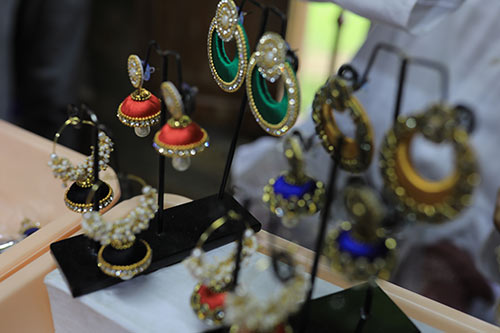Bandhani
This traditional technique is the largest craft being practiced today in terms of volume and number of artisans. Today all tie-dye is considered one. Traditionally however each community had its own designs and Khatries (traditional dyers) who would make odenies, sarees, chuneries and other garments for them. Each Khatri specialized in certain designs and fibers. Today only a few of the designs and techniques survive. The work done for the richer communities like Jains, Bhatia etc. have survived while the ones done for communities which have been impoverished with time like the Mutvas, Halaiputras, Bhanusali, Rabaries among others are no longer being made.
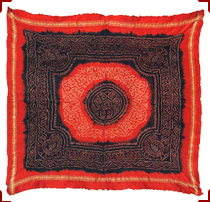
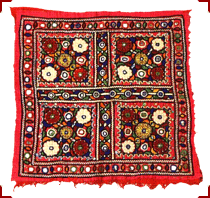
Embroideries
There are over 14 different types of embroideries in Kutch. Many resource centers which supply raw materials, designs, training and quality control are being run by various NGOs. These centers also buy back the finished goods and help in marketing. It is estimated that these NGOs cover 6000-7000 artisans totally. The total number of commercial embroidery artisans in Kutch are over 15,000. This leaves a large number of artisans who are not covered by any support services. These artisans produce low quality merchandise and are very poorly paid. A center which provides support services like design and training for these artisans is required. Many of these artisans market through fairs organized by the Government or supply to wholesalers and retailers. A massive training program for skill upgradation of these artisans is needed so that they produce better quality goods. They also need new designs and color matching which are more suitable for modern markets.
Weaving
About 12 years back it was estimated that the numbers of weavers in Kutch exceeded 2000. Today the number has reduced to fewer than 1200 weavers. The biggest product of these weavers is shawls made of acrylic yarn. The price of the yarn has almost doubled in the last few years but the selling price has been almost same. This has greatly reduced the wages and profit after accounting for inflation. Many of the bigger weaver families diversified into other fibers like finer quality wool, cotton and silk. This has increased their income and stopped the decline to some extend. This however is at a very small level. More qualities of yarn, fiber and designs need to be introduced. One major bottle neck in weaving in other yarns is the non-availability of yarn in all colors. The dyeing done by the weavers is of very poor quality. No proper dyeing equipment is available. A resource center with proper dyeing facility of yarn will further enhance the competitiveness and quality of the Kutchi weavers.
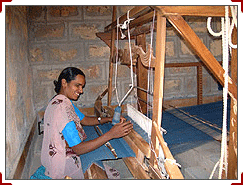

Block Printing
Ajarakh block printing was a very thriving industry before the earthquake. Located around Dhamadka, the workshops suffered massive damage during the earthquake. Among all the crafts this craft needs big workshops and capital investment in blocks and dyeing equipment. Over the years the Khatries has invested their surplus funds in infrastructure like printing sheds, washing units and blocks. Large damage was suffered to them during the earthquake. Also due to change in water quality majority of the units migrated to other villages like Ajarakhpur and Kotda making the remaining infrastructure redundant. This relocation played havoc with the industry and the printers are still struggling to recover fully. Today there are around 125 workshops carrying out this work in over 8 villages.
Mashroo
Mashroo is a fabric being woven in Kutch and Patan for many centuries. It is essentially a satin weave fabric using silk and cotton. Over the last couple of decades art silk replaced silk. This traditional weaving was almost extinct. It was being done in the area around Mandvi. The efforts of Hiralaxmi Memorail Craft Park have ensured that one artisan has restarted this work and has enough orders to continue production. We hope to stabilize this weaver and then encourage other weavers to do this work. Presently the craft needs only its samples to be kept in the resource center and ensure that the weaver gets orders on a regular basis so that other weavers are encouraged to join this trade. Based on the success of the one weaver a plan will be made for further expansion of the production.
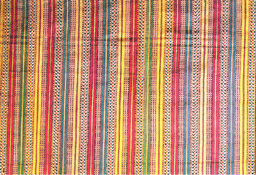
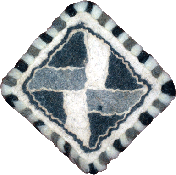
Woolen Namda
Namdas are non woven felts made by hand using local sheep wool. The wool fiber is dyed in various colors and intricate designs are made. The biggest traditional use of this was in making saddle blankets. Once widely practiced, this craft slowly died out and the artisans kept reducing. Till a few years ago there was only one artisan left in Mundra who was doing this work part time. The efforts of HMCP have ensured a couple of other families have also started production of this craft. However this craft faces a problem of poor designs and very low saleability. Design input needs to be provided to these artisans so that they produce better quality products and also to diversify their product range.
Batiq Print
This craft is done in the region of Mandvi and Mundra talukas of Kutch. Batik work is done by applying a resist of wax with wooden blocks or by brush and dyeing of the fabric. The units are of good size and carry out their own marketing. However the designs being done are the same from many years. A massive dose of new designs need to be created. The issues of batik are similar to ajarakh block print and the inputs needs are also similar.
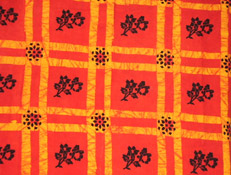
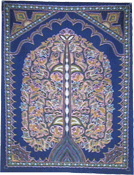
Rogan Painting
The Rogan painting craft is more than 100 years old. Hand-pounded castor oil is turned into a paste by boiling, later coloured powder diluted in water is mixed with the castor oil. The paste of yellow, red, blue, green, black and orange are kept in earthen pots with water to stop the paste drying. An iron rod, flat at both ends, is used to paint half of the design with the support of lefthand fingers, from the bottom of the cloth then is impression is transferred on to the other half portion of the cloth. Cushion covers, bed spreads, petticoats, kurtas, curtains, table cloth, wall hangings are painted with this technique. generally geometrical motifs are preferred. sometimes floral motifs are also adopted. Only 3 craftsmen of Nirona village use this technique
Beadwork
This domestic craft was practiced in virtually every household. Decorative articles were made using fine beadwork individually or to further enhance the look of embroidery or other textiles. Today the craft has degenerated to making very low quality products. A massive design and training input needs to be given so that the craft can regain its past glory. Other related skills like tassel making, blanket stitch (khiloni), knitting buttons etc. should also be revived so that more value can be added to local textiles
